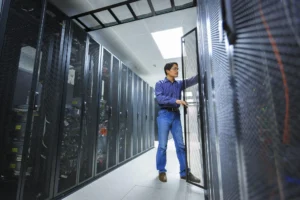With more users, applications, and devices accessing cloud services, branch offices, and work-from-home models, traditional networking architectures no longer cut it. This is where SASE comes in.
SASE converges network and security functions as a single, cloud-native service at the edge. Identity drives access policy with real-time context, including location, device posture, risk/trust, application, and data sensitivity.

Enhanced Security
With cyber threats constantly evolving, organizations need a security solution that is resilient and adaptable. A SASE approach delivers consistent security and optimization across the enterprise edge, including branch offices, remote users, cloud applications, data centers, and local domain networks.
IT teams can create conditional access policies with SASE solutions, integrating them with popular cloud platforms to ensure authorized users access specific applications or data sets. It protects against unauthorized access and minimizes the risk of data breaches by ensuring that only secure connections are made to sensitive information.
SASE solutions for worldwide cybersecurity also provide comprehensive protection for mobile devices and endpoints by integrating with leading endpoint security technologies. It helps IT teams secure a diverse fleet of devices, including smartphones, tablets, and laptops, from the same platform, regardless of location or network connection. SASE solutions are reshaping how cybersecurity is delivered by providing unified threat protection.
By delivering a unified platform for networking and security capabilities, SASE solutions reduce complexity and enable significant cost savings. This is achieved by combining SD-WAN with multiple security functions, such as ZTNA, SWG, and CASB, into a single cloud-delivered service.
It provides a much simpler, more cost-effective, and flexible framework for security that meets the demands of digital business transformation. SASE solutions are built to scale with the needs of enterprises, and they can be installed on existing infrastructure.
Enhanced Mobility
A SASE model offers users, IT teams, and the enterprise several benefits. These include reduced complexity, higher performance, and more robust cybersecurity.
For example, SASE uses a global SD-WAN backbone that avoids latency issues caused by traffic returning to the public internet from corporate data centers and remote offices. It means users experience consistently fast, secure access to cloud resources, SaaS applications, and even the corporate network from any location.
SASE solutions also integrate a complete network security stack and support zero-trust access control. It eliminates trust assumptions about what is connecting to the network and replaces them with fine-grained, identity and context-based permission. This results in greater visibility and control of WAN, cloud, and edge connections and a reduced attack surface.
Another benefit of SASE is its ability to scale with the network and user base. This is because it’s a service model that integrates a network and a security framework in one solution instead of separate products.
As such, organizations can leverage a single SASE vendor to simplify operations and management and reduce costs by reducing the number of products and vendors they need. Additionally, because it’s a unified service, SASE provides faster and easier deployment and auto-provisioning across all networks and devices.
Enhanced Flexibility
SASE solutions are cloud-native and offer a flexible architecture to adapt to dynamic business needs without additional hardware investments. It allows IT teams to scale security capabilities up or down based on user needs without disrupting network operations and performance.
The combination of software-defined wide area networking (SD-WAN) and security capabilities enables SASE to address many challenges associated with today’s evolving cyber threat landscape.
For example, forwarding remote user traffic to a central data center to be inspected and verified by firewalls could be more efficient and effective when users access network resources outside the enterprise perimeter.
In addition, this method of inspecting and verifying traffic can be slow, which could be better for a remote workforce. SASE solves this by moving inspection and verification to the network’s edge, enabling users to connect directly to critical applications with high bandwidth and low latency while protecting the organization from threats that can move laterally through the system after entering the corporate network.
In addition, the tight integration of security and networking functions within SASE reduces complexity and functional overlap, lowering the cost of hardware, software, and maintenance for organizations.
SASE also improves security posture by leveraging Zero Trust Network Access (ZTNA) principles and consolidating network access control into a single policy table based on identity rather than device or location.
Enhanced Performance
Rather than relying on a central data center to secure network traffic, SASE solutions integrate security and networking functions. This approach boosts usable capacity and resiliency at branch offices and remote users while improving performance and optimizing access to cloud applications and services.
This is especially important because more business functions are now hosted outside the enterprise data center, including software-as-a-service (SaaS), cloud storage, and IoT devices.
Legacy inspection and verification methods often “hairpinning” these devices and remote users to the data center for security checks, which slows down productivity and hurts the user experience.
SASE leverages SD-WAN and security capabilities like CASB, DLP, malware detection, zero-trust network access, and branch FWaaS to provide an integrated, unified service. It reduces management complexity and allows IT teams to monitor user and application behavior and respond quickly to security threats with a single interface.
SASE also supports policies set via the cloud and enforced at PoPs close to end users, ensuring consistent performance no matter where remote users connect or what apps they seek.
It makes it easier for users to get up and running and stay productive, regardless of location or working onsite, at home, or in the field. It also improves the experience for IoT, cellular, and wireless users using public networks to access their work.







